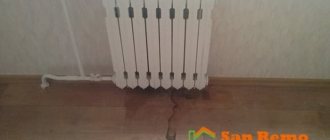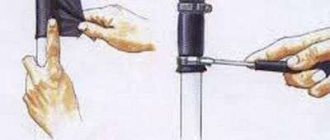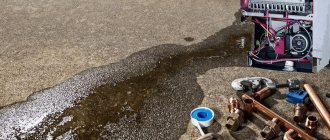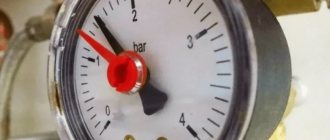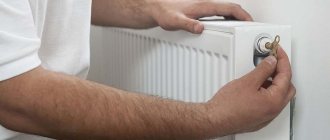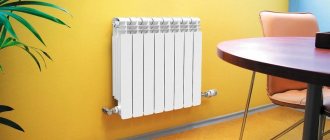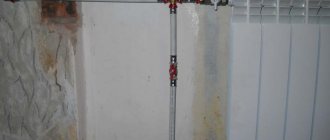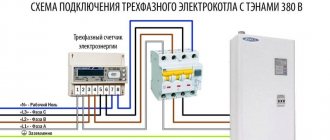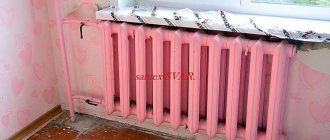In autumn, the home heating season begins. However, while some citizens are already satisfied with the microclimate of their home, others worry if the heating radiator does not heat up completely and are wondering what to do.
The first task will be to find out the circumstances that influenced the occurrence of such an unpleasant situation.
Blockage in the heating system
The reason for the insufficient heat of the battery may lie in a blockage. The blockage is explained by the fact that after a long period of heating operation, the internal diameter of the pipes could be significantly reduced due to the appearance of rust. As a result, it may turn out that there is no room in the pipe for the circulation of coolant flow. In such cases, it will be necessary to carry out work to clean the battery or completely replace it. To clean or replace the radiator, shut off the coolant supply to the bypass. In this case, the entire system will continue to work. If you can get by with just cleaning, you can use the tips below:
It is important to remember safety, as the coolant can be very hot. Cleaning should only be carried out under high water pressure. Before reinstalling the radiator, you should check the pipe connections; there may also be a blockage at the joint that can be cleaned. It is recommended to clean the radiators all at once.
What to do if the bottom of the battery is colder than the top?
If the battery is hot on top and cold on the bottom, it is not functioning properly. In this case, diagnostics are required not only by the battery itself, but also by the entire heating system. The cause of the problem may lie in recent work on the heating system and replacement of the radiator. As a rule, the “hot top – cold bottom” problem appears due to an air lock (99% of cases) or a clogged radiator valve (a consequence of improper start-up of the system).
This problem is solved in two ways. You can remove the air lock using a Mayevsky tap or a bleeder. First of all, turn off the coolant supply to the radiator and leave the return line open. Open the drain, wait until the air comes out, close the drain and open the coolant supply. As a rule, this is enough.
If this method does not work, and we are talking about an apartment building, it is better to call a specialist. For private houses there is another option. First you need to turn off the heating supply, open the drain at the highest point of the system and use back pressure to squeeze out all the air.
Each heating system may have its own characteristics, and therefore there is a high probability of atypical problems arising. These include incorrectly selected pipe diameters, incorrect coolant distribution, poor throughput, lack of pressure, problems with the circulation pump or expansion tank. In any case, only a specialist can fully understand all the nuances, so in case of difficulties in solving the problem, it is better to seek help.
Often on construction forums people complain about heating systems - the bottom of the radiator is cold and the top is hot. It is worth noting that any radiator on top is warmer than on the bottom, but if the gap between these temperatures is too large, then most likely there is something wrong with the system. Moreover, this means that the battery produces less thermal energy than it should. After all, everyone knows that the efficiency of heating devices directly depends on the uniform heating of their surfaces.
Standard battery temperature
Before wondering what to do when you discover poor heating in an apartment, you need to know what rights consumers have. Heat standards are approved by law and only by checking them can you decide whether there is a discrepancy between them and the services provided.
Only after this should you go and make a complaint about the heating in the apartment or write a complaint about the heating in the apartment (the 2017 sample will be provided to you by the relevant service).
The approved criteria for heat in residential premises are:
- for corner apartments, the optimal temperature is +20;
- in rooms it should be no lower than +18 degrees;
- in the bathroom - +25.
These figures may vary depending on the region.
The norm is considered to be a decrease in temperature in the apartment at night to 3 degrees (during the daytime, a drop of 2 degrees is considered a violation) and if this happens, then a recalculation of the heating in the apartment is required
Whether it’s cold or not in the room doesn’t matter. The consumer is not obliged to pay in full for services that do not comply with approved standards
You can carry out the test yourself using a regular medical thermometer, but for this you need to fulfill 2 conditions:
- Measurements are taken only on internal walls, but the distance from the external wall, if any, must be at least a meter. The thermometer should be kept one and a half meters from the floor.
- You need to add 2 degrees to the results obtained.
And only after that think, if there is no heating in the apartment, where to call and who to complain about poor heating in the apartment. There are several examples of complaints about the lack of heating in an apartment, but, as a rule, it is often enough to report the problem to the Housing Office for a commission to come from there and record the fact that the client is right.
The heating in the apartment does not work, where can I complain? Read about it below.
Causes of failure and solutions
At the initial stage, you should check that the bypass is installed correctly. This element looks like a tube installed in front of the heating radiator. Using a bypass, two pipes connected to the battery are connected. One pipe is responsible for the supply of coolant, and the other for its return movement. Very often the reason that the last radiator does not heat is the installation of a bypass at a distance from its structure.
Often the heating battery, which is the last one in the overall design, stops heating due to its large size. If the radiator has more than 12 sections, the pressure may not be enough to distribute the coolant evenly. In this case, it is recommended to change the battery or cut off some sections.
It is better to entrust such work to a specialist. Also, before cutting, you need to make sure that the coolant supply is turned off. Therefore, it is preferable to carry out repair work during the warm season.
The third reason is improper balancing. Due to this, the coolant is distributed unevenly among the sections. To ensure the operation of the equipment, it must be installed in the correct position. It is also important to make sure that the wall on which the radiator is mounted has a flat surface.
Ways to eliminate the problem of a cold radiator
The presence of an air lock in the battery forces you to act as follows:
- First, the circulation pump is turned off. After all, excess coolant pressure in the system can prevent the elimination of the air pocket in the battery. If the radiator is connected to central heating, this recommendation can be ignored.
- Next, the Mayevsky valve, mounted in the radiator from the side of the free upper fitting, opens. The tap is opened by simply turning the valve clockwise. And they close, accordingly, by turning the valve in the opposite direction. If there is no tap, the plug is rolled up at the same end.
- After this, you will hear a characteristic hissing sound, after which water will flow out of the tap or slightly open plug. Therefore, before manipulating the tap or plug, you need to place some container under the edge of the battery.
- Finally, you close the tap and turn on the circulation pump.
After some time, you should check the results of the work done - touch the battery and evaluate its temperature. If the battery gets warm, you did everything right. True, it will not warm up quickly, so be patient.
Touch the radiator
An insufficient volume of coolant is restored by supplying water to an open expansion tank or by filling a hydraulic accumulator built into a closed system.
Moreover, pumping an additional portion of water into a closed system is carried out as follows:
The circulation pump turns off
- Air is bleed from the hydraulic accumulator. To do this, press the nipple pin.
- At the highest point of the wiring, the air bleed valve opens.
- A shut-off valve opens on the connecting wiring and water supply line. Water will flow into the system directly from the water supply and will fill the wiring until it flows out of the open air bleed valve.
- After this, it is necessary to close the air bleed valve and the shut-off unit on the liquid supply line to the system from the water supply.
- Finally, the air volume in the accumulator is restored by monitoring the pressure level in the system with a pressure gauge.
If after these manipulations your batteries become warmer, you have eliminated the detected defect. However, after the arrival of a fresh portion of coolant, the likelihood of air pockets appearing in the body of the radiator itself increases. We discussed how to fix this problem above in the text.
After all, to eliminate this problem, you need to dismantle the dangerous area and clean the pipe. After which all dismantled elements will be put back in their original place or replaced with new fittings.
Examination by a specialist
The same should be done if, in your opinion, the battery is connected to the wiring incorrectly
Whether you connected it yourself or entrusted such work to some unfortunate craftsmen - it doesn’t matter anymore - just show your wiring to another specialist in heating systems. Perhaps you or the technicians who assembled your system made a mistake
And only another specialist will notice this error.
Radiator malfunction after repair
If your heating radiator does not heat after repair, then the most likely cause of such a defect is either air in the system or an error when connecting the battery to the wiring.
After all, replacement or repair of radiators takes place when the coolant is partially pumped out of the system. Well, after supplying water to the wiring, the risk of air pockets in the battery increases almost by an order of magnitude.
Therefore, when adding water to the system after repair, do not forget to open the plugs or Mayevsky taps, monitoring the filling of the batteries by the stream of water flowing from the battery through the shut-off and control valves. If the moment is missed, then air jams will have to be dealt with using the methods described above.
Bleeding air from the system
Errors in connecting the radiator to the system are possible only in case of unprofessional installation. An inexperienced “home master” may overestimate his skills and abilities. To eliminate the consequences of such errors, you will have to call an experienced professional to your home who can conduct a wiring audit and eliminate the mistake of the previous “master.”
At the same time, most mistakes made by home craftsmen arise when using bypasses and when trying to modify an existing system by combining one-pipe and two-pipe wiring.
We also recommend watching:
- Choosing a parapet type gas boiler
- Gas boilers Siberia (SIBERIA)
- Gas double-circuit wall-mounted boilers NAVIEN (Navien)
- How to choose a thermostat for a heating boiler - review of models
The main reasons for this phenomenon
The problem of “cold bottom” (let’s call it that) is faced not only by those whose system is equipped with fairly old heat exchangers, but also by people who have installed bimetallic heating radiators. There are many reasons why this problem occurs, so it is difficult to immediately say why the batteries do not warm up evenly enough. Typically, each specific case should be considered individually. So, let's try to figure out the main reasons for this malfunction.
Reason #1. Normal blockage
The very first (because the most common) reason for this phenomenon is contamination of heating radiators. Here are the main reasons for the temperature decrease in the lower part of the device:
- low-quality coolant is used;
- air has entered the system.
It is worth noting that the working fluid can contain not only heat, but also various solid particles. For example, when the heating season begins, and centralized lines are just starting up, the quality of the working fluid is, to put it mildly, disgusting. Things are much better in the case of an individual heating circuit - contamination can penetrate into it only through an open expansion chamber.
This is all clear, but how can the temperature difference be affected by the presence of air in the system? The explanation for this is very unusual - bacteria are to blame. There is a certain variety of such microorganisms that can exist only in the presence of a sufficient amount of oxygen. Such bacteria are known as anaerobic. There is nothing wrong with them, but their waste products settle at the bottom of the heating radiator in the form of sediment.
Note! It is also worth noting that the working fluid brings sludge into the battery from almost the entire heating line, and it settles there.
Finally, another reason that the bottom of the battery is cold and the top is hot can be considered the special design of the heat exchanger. The liquid moves in it, permanently changing the vector of its own motion. And inside the heat exchanger there is a fairly large number of “secluded places” in which dirt can be deposited.
Video - Cleaning the heating radiator
This reason is more or less clear, so let’s move on to the next one.
Reason #2. Problems with shut-off valves
Sometimes the reason why the temperature of the lower part of the radiator is lower than the upper part can be due to the shut-off valves. In previous articles we have already examined the design features of such reinforcement, so today we will only briefly consider a few main points. The main purpose of shut-off valves in the heating circuit is to regulate, as well as completely/partially block the movement of the working fluid.
The fittings can be the following mechanisms.
- Ball valve.
- Thermal head, which is equipped with mechanical or electronic control.
- Cone valve.
But what does the decrease in temperature at the bottom of the radiator have to do with it, you ask? The fact is that as a result of problems with shut-off valves, the circulation of the working fluid inside the heat exchanger is disrupted. After all, the tap may simply become unusable, which is why the coolant will not flow even in its open position. This, for example, could be a failed damper or any other mechanism failure. It is also worth adding that the correct installation of shut-off valves also plays a very important role in this case.
Note! All taps of this type have an arrow indicating in which direction the working fluid must move in order for the heating line to function normally.
And if the tap is installed incorrectly, then one way or another the movement of the coolant will be disrupted: in this case, it will not matter whether the damper mentioned above is closed or open. We also note that for some types of shut-off valves there are requirements regarding the position in which the valve itself should be located relative to the space. For this reason, in case of problems with the uniform heating of heating devices, the shut-off valves should also be inspected.
Thermostat for heating radiator
Previously, we talked about the types, applications and technical characteristics of thermostats for heating radiators; in addition to this article, we advise you to read this information and read about it here
Reason #3. There is not enough pressure in the system
Low pressure in the line can lead to disruptions in the circulation of the working fluid, as a result of which it may happen that the bottom of the battery is cold and the top is hot. What to do in this case? First, you should make sure that everything is normal with the pressure in the network. As you remember, not so long ago - and we are talking about the times of the Soviet Union - batteries made of cast iron were widely used. They differed in that they had fairly wide passages, therefore, in order for the working fluid to pass through the entire heat exchanger, not so much pressure was required. But modern heating radiators have a slightly different structure.
Quite often, even immediately after purchasing such batteries, people encounter a problem when the upper part has a much higher temperature. This is explained by the fact that the output and inlet pipes, as well as the labyrinth of the heat exchanger itself, have a small nominal bore. For this reason, in the line, which was originally designed for cast iron, the pressure is simply unable to overcome the resistance and “push” the working fluid through the entire heat exchanger.
There is an air lock in the battery
If the batteries at home do not heat or heat poorly, the most obvious problem is an air lock in the battery. An air lock can prevent the normal circulation of coolant in the system, which leads to cooling of the radiators.
Today, with new systems, everything is much simpler, because they are equipped with a special tap through which you can bleed air. Usually the faucet is installed on the battery at the top, or it needs to be turned with a screwdriver, or, if you have a special adapter, then simply by hand. In this case, a hiss will follow - if there is still air in the system. If there is no air, the coolant and water will immediately begin to flow out. If the second option, then the problem is not in the airlock and you need to look for another reason.
Don't keep the tap open for too long. After all, if you let in too much coolant, your heating system may suffer a loss of pressure and the boiler will stop altogether. So it is better to repeat the procedure after a while until there is definitely no air in the system. Then the operation process should normalize and the batteries will warm up.
It's worse if you have an old cast-iron radiator, because most likely it is not equipped with a drain valve. It’s good if you made repairs and at least changed the supply pipes, in which case you can bleed the air through a new tap, but if not, then everything is a little more complicated and you will most likely have to get dirty. If there is an air lock in a cast iron battery, then you need to find the connection in the pipe on the approach to the battery, which is connected by a coupling and turn it. Yes, most likely dirty coolant will stain your floor or clothes, but the heating system will definitely work more efficiently
It is IMPORTANT not to use unnecessary force, because the thread can unscrew in different directions and it is important not to break it, because then everything will be much worse and you will definitely have to call a plumber to solve the problem. If suddenly the coupling breaks completely, then it will be very bad, even that you can flood your neighbors below. So, at your own peril and risk, unscrew the coupling very smoothly, or still call a plumber
As soon as you hear a hissing sound, stop twisting, bleed the air, and as soon as water begins to flow, tighten it back. It’s a fairly common occurrence that when you break ancient pipe connections, water then oozes out of them, so before screwing them back in, you can use tow or fumlent. I hope everything goes well and you will enjoy the warm radiator. If not, then read on, perhaps the problem is as follows.
The boiler does not heat the radiators
Boiler heat exchanger before and after cleaning
Often, a two-pipe heating system does not heat due to the low heat transfer rate of the boiler exchange circuit. This leads to a decrease in temperature and, as a consequence, a loss of efficiency of the entire system. Not every boiler model provides an easy way to dismantle the heat exchanger. If the heating does not heat well due to the appearance of plaque on the internal elements of the boiler, you can perform flushing without this procedure. To do this you will need a pump with a filtration system. The cleaning procedure is as follows:
- Disconnecting the boiler from the general heating system;
- Connection to the inlet and outlet pipes of the pump hoses;
- Filling a special cleaning liquid into the boiler heat exchanger;
- Using a centrifugal pump increases the speed of fluid passing through the boiler.
After this, the radiators should not heat up poorly. Particular attention should be paid to the flushing fluid. It should not harm the metal elements of the boiler and system. Therefore, at the end of the procedure, the entire system should be rinsed with distilled water.
To avoid the appearance of scale, before pouring water into the heating system, you need to reduce its hardness level. The use of running water is not recommended as it contains large amounts of calcium and magnesium bicarbonates. They are the main source of limescale deposits not only in the boiler heat exchanger, but also in pipes and radiators.
The best way to clean the heat exchanger is to dismantle it. This way you can not only remove the entire volume of scale, but also ensure its integrity. After this procedure, the heating system should not heat poorly.
Independent solution to the problem of cold batteries
If you decide to act on your own, then you can think about what problem could lead to the low temperature of the radiator. The most common case is air locks. If the house has radiators of the latest generation, then they must be equipped with a Mayevsky tap; it has a hole for air removal. It is usually installed at the top of the battery, since air accumulates there.
If you turn the tap clockwise, you will hear a characteristic hissing sound. Once water begins to seep out, the tap can be closed. In order to make sure that the air has completely escaped, even after water has seeped out, you can keep the tap half-open, since air currents can escape with the liquid.
If the radiators in the apartment do not heat well, it is, of course, important to decide what to do. Experts say that it is not worth reducing the volume of water in the radiator for a long time; it will be more effective to open the tap after a while
This will allow the water and air to restart.
Local causes of heating system failure
The last battery is too long.
Why is one battery hot and the other cold? Experts cite the following reasons for this situation:
- airing of the system;
- low quality coolant;
- poor quality heating element.
In most cases, the above problems can be resolved by homeowners themselves. However, the help of a specialist is never superfluous.
Today, cross-linked polyethylene pipes are most often used for heating.
Find out whether it is possible to paint heating pipes made of plastic here.
Airing the system. Air may accumulate in individual elements of the heating system. This phenomenon is called circuit airing.
Air can get into the wiring:
- from an open expansion tank;
- if ordinary tap water was used as a coolant. It contains a certain percentage of dissolved air;
- the aggressive coolant environment oxidizes the walls of aluminum radiators. As a result, oxygen is released. It accumulates inside, forming a plug.
It is easy to determine whether there is an air lock inside the heating equipment. To do this, you need to simultaneously turn off the taps on the supply and return pipes, and then open them in complete silence. If there is extraneous noise and gurgling inside the device when the tap is opened, there is an air lock there. This is the main reason why one battery is cold and the rest are hot.
This video will help you remove air jams:
Debris and rust in the heating circuit can also explain why your last radiator is cold. Foreign objects block the flow of hot water, thereby reducing the efficiency of heating the house.
Why the batteries in the apartment do not heat up - diagnostics and localization of the problem
Batteries (radiators) are installed in heating systems with forced or natural circulation of coolant (in most cases, water) heated by a boiler. Therefore, the only reason for the low temperature of the battery is the cessation of the flow of heated coolant.
The following defects in the heating system can provoke a violation of coolant circulation:
- Air lock inside the heating system elements. The accumulation of air prevents the movement of coolant. This defect is diagnosed either tactilely - the area of the system behind the air lock will be colder than the area of the wiring where the coolant is still circulating, or by sound - at the initial stage, the formation of an air pocket can be calculated by the characteristic “murmur” of the coolant being forced through the dehydrated section of the battery or pipe .
- Insufficient coolant volume. Insufficient water will lead to airing of a significant area of the wiring - the coolant simply will not be able to circulate. In such a system, only the boiler and a small section of wiring behind the heating device will be hot. If you observe such a “distortion” in the heating of the system, then be assured - the cause of your inconvenience has been established.
- Blockage in pipes. This is a very rare defect, observed only in outdated heating systems built on the basis of steel pipes. Modern metal-plastic or polymer wiring is free from such problems, since the main source of congestion is the rust accumulated in the pipes, clogging the narrowest section of the wiring. Simply put: if the area behind the pipe with the smallest diameter has “cooled down,” then the likely cause of the “cooling” is the rust accumulated in this area.
- Error when connecting the radiator to the pressure and return pipes. In this case, the entire radiator will cool down, but the pipe will remain hot.
In a word, if your battery does not heat well, localize the problem, find the cause of the breakdown and proceed to fix it.
Can I solve the problem myself?
If the batteries continue to remain cold at the beginning of the heating season, there is no need to immediately panic.
You can try to solve the problem on your own. For example, the riser is hot and the radiator is cold. The reason is that hot water is not entering the system. To fix the problem, it is worth checking the position of the tap that provides access to the coolant. It's probably locked. To correct the situation, simply open the tap: water will flow into the battery and the heat supply will resume. You also need to make sure that the riser is not blocked for the purpose of carrying out repair work in the basement. In this case, the riser will be hot and the battery will be cold.
But if there is no heating in one room, the reason probably lies in the formation of air pockets in the battery. In apartment buildings, this situation occurs quite often. A gurgling sound in the battery may indicate that air has accumulated in the system.
If the heating system is airy, the coolant cannot circulate freely throughout the battery. In addition, the air does not allow heat to flow through. And this leads to the fact that the room is not heated completely and not evenly. The accumulation of air also negatively affects the service life of the heating device. Because it causes rust formation.
If the heating system is airy, what should you do to remove the air lock?
Actually, it's not hard. First you need to determine how water circulates in the system: naturally or forced.
In systems with natural coolant circulation, the air lock is removed through the expansion tank. It is located at the top point of the system. If the wiring is from the top, the supply pipeline approaches the expander at an angle. With lower wiring, air is released, as in systems with forced circulation.
Let's look at how to remove an air lock from a heating system with forced water circulation. This system requires the presence of an air collector. Air bubbles accumulate in the air intake. And they are removed through special taps. Therefore, in order for excess air to escape, you need to open the tap. Sometimes automatic air vents are installed at several points in the heating network.
It happens that air is formed not in the room radiator, but in the pipes that are located in the basement. In this case, you need to contact the housing and communal services department and call a plumber. He will arrive and open a special valve to bleed off the air.
Uneven heating of the heating device can also be caused by incorrect connection of the heating system. For example, some sections are well heated, while others are cold. When the battery is connected sideways, the coolant does not flow throughout the entire system, but chooses the shortest path. This may cause the bottom of the battery to be cold. To solve this problem, it is better to connect the battery diagonally. But such work should only be performed by a highly qualified plumber.
The battery may be cold from below due to contamination. Rust and scale settle at the bottom of the system, on the walls of the radiator. This blocks the path of the coolant. In this case, the battery should be cleaned. To do this, it is washed several times under pressure with water.
UFP FBLPE RTPDHFYE VBFBTEC
ЪБУЭН ФП DEMBAF ЪЛПЗДБ? LBLYE NY DEKUFCHYS DPMTSOSCH VSHFSH RTY LFPN (CHLMAYUYFSH/CHSHLMAYUYFSH VBFBTEA, URKHUFYFSH CHPDKHI (LBL?))?
| nal 02 DELBVTS 2003 ZPDB |
chPPVEE-FP RTDDHCHLH DEMBAF CH DCHHI UMHYUBSI: -OBMYUYE CHPDHIB CH UYUFENE; — OBMYUYE PFMPTSEOYK CH VBFBTESI. h RETCHPN UMKHYUBE CHP'DHI KHDBMSAF U CHETIOEK FPYULY UYUFENSCH (YMY VBFBTEY). DMS LFPZP PVSBFEMSHOP OBMYUYE F.O. ChPЪDHOYOLB - LFP PVShHLOPCHEOOSCHK CHEOFYMSH CHCHETIKH VBFBTEY YMY CH CHETIOEK FPYULE UYUFENSCH PFPRMEOYS DPNB (VSCHCHBAF ABOUT YUTDBLBI YMY ABOUT VBFBTESI UBNPK CHETIOEK LCHBTFYTSCH). rTEDHUNBFTYCHBAFUS ABOUT LBCDPN UFPSLE. rTPDKHCHBAF CHOBYUBME RTY RPMOPUFSHA PFLTSCHFSHCHI RPDBYUE Y PVTBFE (TBHNEEFUS RPDUFBCHYCH CHEDTP Y OKHTSOP EEE OBDEFSH YMBOZ ABOUT CHEOFYMSH, YUFPV OE VTSHCH'ZBMP). yOPZDB RTYIPDIFUS DEMBFSH bFH PRETBGYA OEPDOPLTBFOP. eUMY OE RPNPZBEF, FP ЪBLTSCHCHBAF RPDBYUKH Y RTPCHPDSF FE CE DEKUFCHYS (PVTBFLB RPDBEFUS UOYH Y CHSHCHFEUOSEF FEN UBNSHCHN CHPDKHI). rPUME RTDDHCHLY (LPZDB RETEUFBM YDFY CHPDKHI) PFLTSCHCHBAF RTSNHA. h UMHYUBE ЪBOPUB VBFBTEK PFMPTSEOYSNY OEPVIPDYNP RTDDHCHBFSH U OITSOEK FPYULY VBFBTEY.
Pipelines: reasons for low heating
Determining air pockets in batteries using a thermal imager
Failures in the heating mode are typical for a two-pipe heating system. In this case, the supply line that distributes the coolant to the radiators does not heat. Identification of the “problem” area can be done by measuring the temperature on the surface of the pipes or a thermal imager.
Natural circulation
Pipe slope for heating with natural circulation
What could cause such problems? If the heating does not heat well, the slope of the line may not be observed. This only applies to natural circulation systems. According to the standards, the slope of the pipes should be 10 mm per 1 m.p. In addition, the direction is taken into account - from the accelerating riser to the radiators. For the return pipe, the slope must be towards the boiler.
At the first stage, it is necessary to measure this indicator using a building level. If it meets the standard, but the heating radiator does not heat, there is a possibility of air pockets forming. In this case, an integrated approach is recommended, which includes the following steps:
- Measuring the angle of inclination. If necessary, change it to the required value;
- Flushing pipes to remove limescale;
- Filling the system with coolant with open Mayevsky taps on the radiators.
This technique will eliminate the low heat transfer rate of the heating system.
To improve circulation, a circulation pump can be installed in open systems. If it overheats, you need to install an additional one. This is often necessary for branched heating systems.
Forced coolant circulation
Operating principle of the air vent
For a system with forced movement of water in pipes, the formation of air locks can be avoided by using an air vent installed at the top of the system. In part, it performs the functions of an open expansion tank, but it does not reduce the pressure in the pipes to a critical level. Its absence is an indirect cause of poor heating of the radiator.
The specificity of closed heating systems is that it is not necessary to comply with the installation level of the pipes. However, when the critical heating level of the coolant is exceeded, steam is released, which is the main cause of air locks. Since air has a lower density than water, it will concentrate in the upper region of the pipeline sections. If heating radiators in a closed system do not heat well, the reason may be a decrease in the volume of coolant in the pipes due to air resistance.
What needs to be done in this case? First of all, check the functionality of the air vents. If the valve is idle for a long time, it may become covered with limescale, which makes it impossible to open it under air pressure.
In addition to this factor, it is necessary to take into account the excess of hydraulic resistance in the system. This is why the heating battery does not heat if the initial calculation is incorrect. Therefore, before you begin installing a new system or upgrading an old one, you should perform the calculation of the operational and technical parameters:
- Selection of pipes of the appropriate diameter - the larger it is, the lower the hydrodynamic resistance. However, this increases the volume of water;
- The likelihood that a two-pipe heating system will not heat is significantly less than that of a single-pipe one. Therefore, it is preferable to install radiators with parallel connections;
- Heating of the heating circulation pump occurs due to incorrectly selected power. It directly depends on the calculated hydrodynamic parameters.
For what reasons may the radiator not heat up? This may be due to an incorrectly selected radiator model. Each of them has a certain heat transfer rate depending on the thermal operating conditions of the system. These data are indicated in the device passport. If you choose the wrong model, then even with ideal operation of the heating system, the radiator simply will not heat up to the required temperature.
The video shows the main reasons for poor radiator heating for a single-pipe heating system:
Why is the battery not all hot?
The efficiency factor (efficiency) depends on the uniform heating of the heating battery. If this indicator does not reach the optimal level, then there is no need to talk about a comfortable temperature in the room.
A hot top and cold bottom of the radiator occurs not only in old cast iron systems, but also in innovative bimetallic systems.
Airy battery
The problem is most typical for multi-storey buildings and upper floors. This is due to the laws of ordinary physics - air flows are always directed upward.
The concept of airiness means the presence of accumulated air inside the heating system, which is why water flows cannot fully move through the pipes and radiator.
If the apartment has old-type batteries installed - without a Mayevsky tap, you will have to call a mechanic from the housing office to remove the air. But first, try to bleed the air from the battery yourself:
- Find the coupling that is located at the junction of the pipe and the approach to the battery.
- Unroll it, after which the water will flow out, and the air will go with it.
Don't forget to place a basin to drain the liquid. Otherwise, water will flood the floor and flood the neighbors below.
If this is a private house, then the problem can be solved simply:
- Shut off the general heating supply.
- Open the bleeder located at the top of the system.
- Remove air using back pressure.
It is much easier to eliminate stagnant air masses in modern radiators that are equipped with special taps. How to do it right:
- Turn off the tap on the pipe supplying hot water to the battery. Leave the return valve open.
- Open the bleeder valve and wait a few minutes, which will allow all the air to leave the system.
- Close it and turn on the water.
If such actions do not change the situation, then the problem lies in another cause.
Radiator. How to remove air? Top Hot, Bottom Cold...What to do? (2021)
Simple clogged radiators
The second most common cause of cold bottom and hot top in radiators is the accumulation of contaminants inside the system. There are many reasons:
- Poor quality thermal fluid. This is a problem for any city and country. Low-grade untreated water containing various impurities is used for heating. In the normal state, they easily move through the coolant. When heating occurs, the particles form a larger fraction, which settles on the surface of the metal.
- Garbage from outside. This applies to heating systems that do not depend on central heating. Dirt penetrates into such autonomous circuits through open hydraulic tanks. As a result, all the debris, along with the flow of water, ends up in the heating radiators, which completely disrupts the circulation of coolants.
- Air accumulation. In this case, an accumulation of anaerobic bacteria occurs. They exist due to the presence of oxygen in the heating system. During their life, microorganisms release waste products. They settle on the inner surface of the radiator, and when they accumulate, they create a dense sediment that interferes with the circulation of water flow.
- Heat exchanger design. There are batteries in which water, when moving, changes the vector of its movement in a permanent way. As a result, dirt is deposited in hard-to-reach corners.
If the problem of the cold bottom is clogging, 2 methods of eliminating it are used - chemical and mechanical. What you can do yourself:
- Remove the battery. To do this, disconnect the device from the pipes using tools.
- Drain the radiator.
- Tap all sections with a rubber mallet or mallet. The action will allow the rust and plaque to separate from the surface.
- Shake the battery. Turn over so that debris comes out from inside to outside.
- Take a sealed hose, pour hot water into the battery through it, and add a special detergent. Leave for 30 minutes.
- Drain the boiling water, reinsert the hose connected from the back to the cold water tap. Turn on full pressure and rinse with flow. Such intensive actions remove all remaining debris.
When calling specialists, electrohydraulic pulse, hydropneumatics or hydrodynamics are used.
Malfunctions in shut-off valves
The shut-off valves are located in the heating circuit, acting as a water flow regulator and a shut-off element when moving the working fluid. Consists of a ball valve, an electronically/mechanically controlled thermal head and a plug valve.
If a malfunction occurs in the shut-off system, the circulation of the coolant is disrupted. To correct the situation, carefully inspect the fittings and replace the faulty part. If it is difficult to do this on your own, hire a specialist.
The bottom of the BATTERY is Cold and the Top is Hot (7 REASONS)
Insufficient pressure in the system
The problem most often occurs in modern type radiators. The reason is the structure of the structure. If in Soviet-era batteries the passages were impressive, then in the updated versions they are narrow, so an increased level of pressure is required for normal and stable movement of the working fluid.
The passages include such elements as the labyrinth of the heat exchanger, pipes (inlet and outlet).
If the line was originally intended for cast iron systems, then it will not be able to generate the necessary pressure for modern models with narrow passages.
There are other reasons:
- faults in the main line - repair is required;
- connection of a heated floor by neighbors - in this case, more pressure is required, and since the heating system is located in the lower part of the room, the bulk of the pressure is directed there;
- the presence of a valve on the bypass slows down the pressure;
- increasing the number of sections (including neighbors) - more pressure is required;
- neighbors regulate their radiators, which negatively affects the flow of coolant in nearby apartments.
Why does low pressure make the bottom of the radiator much colder than the top? The answer to the question has the following variations:
- the balance is disturbed;
- air jams form;
- the coolant cools quickly;
- incorrect cross-section in the pipeline;
- low power of pumping equipment;
- water leakage occurs (as happens with heated floors).
Methods for solving the problem:
- call the management company, since it is impossible to fix the problem yourself;
- if breakdowns are not detected, then the culprits are the neighbors who made adjustments to the heating system without informing the heat supplier.
Such actions are considered illegal. When heating conditions for apartments change, the supplier must adjust the pressure level to ensure even distribution of the coolant.
Incorrect installation and connection of radiators
When connecting heating radiators, specialists adhere to a certain scheme. If this is not done, then not only does the bottom become cold, but other problems also arise (the risk of pipeline rupture increases).
Most often, the valve is installed incorrectly on the bypass (this is a pipe connecting the return pipe and the internal supply element of the working fluid). When connecting heating, the bypass must be closed, and preferably installed closer to the battery.
The heating radiator malfunctions for other reasons:
- incorrectly selected pipe diameter;
- incompatibility of battery and boiler.
To solve the problem, check the installation according to the connection diagram. In this case, it is better to contact specialists.
The coolant is moving at insufficient speed
The speed of the coolant is influenced by several factors. They are as follows:
- characteristics of water;
- diagram of the entire heating system (it does not have pumping equipment, but works by gravity, etc.);
- performance and power of the pumping unit;
- pipe diameter is narrow;
- equipment clogging;
- material used in the manufacture of batteries and pipes.
The coolant movement speed for private houses and apartments should vary from 0.5 to 1.5 m/sec.
The bottom of the radiator becomes much colder than the top because the water has time to cool due to its slow movement. Having reached the return line, the working fluid is already completely cold.
It is almost impossible to identify the cause on your own. You will have to contact the coolant supplier. If the cross-section of the pipes is narrow, you need to replace this part of the water supply; if the power is weak, increase it; if the material of the equipment does not hold heat, you need to buy a new one, etc.
Here we answer the question - why water is used in heating radiators, the pros and cons of this coolant.
If the battery does not warm up completely
Cold room
The bottom of the battery may be cold if the heating radiator is located in the veranda/corridor of a private house or on the loggia of an apartment. When the air temperature is cool, metal surfaces quickly cool, which is why the working fluid also cools.
Since the water is initially directed along the top of the battery, and then along the bottom, there is a corresponding temperature imbalance - the bottom is colder than the top. Another reason is that the cold is more concentrated in the floor area, and the heat is concentrated at the top, in the ceiling area.
Rules for filing a complaint
When there is poor heating in an apartment, what should you do? There are temperature standards in residential premises that heat suppliers must adhere to.
If cold batteries are a constant phenomenon, then you should rightfully protect your interests as a consumer. First you should ask your neighbors on the site or entrance. Perhaps the problem is only in the operation of the riser or individual batteries.
In this case, it is enough to call a good, experienced plumber from the management company, who will check for air pockets or other phenomena that interfere with the excellent operation of the heating system. If it’s cold throughout the house, you need to make a complaint according to all the rules:
- The first instance is the Management Company or Housing Office that maintains the house.
- Then comes the Department of Housing and Communal Services at the local municipality or Housing Inspectorate.
- If they do not respond, a statement is filed with Rospotrebnadzor.
- And only after the above points of appeal can you go to the prosecutor’s office and the court. A complaint or claim is an important document that must be drawn up in accordance with all the rules of business papers. The accuracy and reliability of the information is important. The authority to which the application is submitted is indicated. Then you need to provide the applicant’s details, leaving contact information for feedback.
- Then a detailed description of the problem is given. It is necessary to indicate when the heat supply stopped and what measures were taken in this regard. If the paper is submitted, for example, to Rospotrebnadzor, you need to submit correspondence with the Criminal Code and the Department.
- Another important point is the presence of an inspection report that will confirm the lack of heating or low temperature of the air and radiators.
- At the end of the letter, you should express your demands and complaints to eliminate the problem and recalculate heating payments. It is necessary to indicate the intention to go to court if there is no response to this letter.
- The document is signed and the date of its preparation is set.
How to act
Most apartments are still connected to a centralized heating system; their owners cannot regulate the temperature in their living spaces themselves. If one of the residents of an apartment building discovers only slightly warm radiators in the apartment, what should be done in this case?
It is your management company that should be contacted first when a low battery temperature is detected. The temperature in the apartments must meet the standards; management employees are responsible for this:
- A call to the management manager is the first step in case of poor heating. You can assign the call to the chairman of the house council. The dispatcher may know why the heating system in a house or neighborhood is not working well. In this case, he reports the cause of the problem and the time frame for its elimination.
- If there is an accident, the dispatcher must report whether repairs are being carried out and when they are completed.
- Certain time standards have been established for eliminating a heating system failure during the heating period.
- Due to accidents, heating may be out for no more than 24 hours per month.
- If the temperature drops to 12 degrees, heating cannot be turned off for more than 16 hours.
- When the temperature in the apartment is below 12 degrees, turn on the heating after at least 4-8 hours.
- If these time standards are violated, consumers have the right to demand a recalculation for this service.
Why do batteries warm up poorly in a private home?
Just as in the case of a high-rise building, there may be several reasons for the poor performance of heating batteries in a private house.
Reason 1: problems in the hydraulics of the heating system
The most common reason why radiators remain cold is due to the hydraulics of the heating system. In this case, one of the heating branches is working properly, and the second is intermittent. This picture is typical for a new heating system or when adding radiators to an existing one. If the hydraulics are incorrectly calculated, and in particular the diameters and lengths of pipes, some batteries may simply not heat up. You can adjust the hydraulics using special taps.
Reason 2: single-pipe heating system
In many private homes there are single-pipe heating systems. In such a system, batteries remote from the boiler often heat much worse than those nearby. This does not mean that there are problems; this is the nature of the operation of a single-pipe system. The only solution here can only be to replace the system with a two-pipe one.
Reason 3: boiler malfunction
The batteries may not warm up due to malfunctions in boilers with built-in automation, pumps and sensors, which is a typical problem for autonomous heating systems. In this case, you must contact a specialist who works with such equipment directly.
Poor heating in the apartment: where to complain
Where can I complain about the lack of heating in my apartment? Often, residents of multi-storey buildings simply do not know where to complain when there is no heating in their apartment, and believe that they need to immediately go to court. This is fundamentally the wrong approach.
To file a complaint about poor heating in an apartment, there is also a sequence of actions:
- First, you need to start with your housing office or organization that provides heating services.
To do this, in our time it is absolutely not necessary to go to these institutions and stand in queues there. It is enough to call and file a complaint, writing down the name of the person who accepted it and the number under which it was included in the application registration book. A personal visit to the utility service will speed up the process of reviewing the complaint, and service workers can come on the same day to document its legitimacy. By law, heating network technicians are required to check the cause of the complaint within two days. If they did not appear or considered that the consumer’s claims were unfounded, then you can move on to the next stage of action.
Secondly, the following complaint about poor heating in the apartment (a sample is provided in the office) is submitted to the head of the housing office or the organization supplying heat. You can go further and immediately send your application to the head of the housing and communal services department of the district administration.
All applications must be submitted in duplicate, indicating their number in the registration book, the date of submission, the signature of the person who accepted them and the stamp of the organization.
By law, the service to which the complaint was sent is required to respond to it within 30 days. Only after these authorities have ignored the statements and measures to correct the problems in the heating system have not been taken can it be possible to sue the heat suppliers.
Typical errors when connecting radiators and methods for eliminating them
Sometimes after replacing the batteries, a sad picture is observed - the new radiators remain cold, despite the fact that the old elements somehow warmed up. The reason in this case may be an incorrect connection to the riser. If the upper pipe through which water is supplied and the lower pipe through which it drains are connected on one side, the circulation of the coolant may be difficult and some sections in the battery will not be able to warm up sufficiently. This problem often happens in homes where there is insufficient water pressure in the heating system.
This should be the ideal battery connection diagram
To avoid this, experts connect the input and output diagonally (top and bottom on different sides) - this option allows hot liquid to circulate freely throughout all compartments of the radiator. If the system is already connected, then there is no need to resort to drastic measures. To correct the situation, you can use a special extension cord in the form of a cone-shaped tube. It is connected to the fitting of the pipe that supplies hot water to the battery. This measure allows you to shift the entrance and significantly improve circulation.
Causes of problems with return flow in the batteries of a private or apartment building
There are several reasons why the return flow is not warm enough or even cold. Common problems are:
- insufficient water pressure in the system;
- small section of the pipe through which the coolant passes;
- incorrect installation;
- airiness or contamination of the system.
If a problem with cold return occurs in an apartment, then the first thing you should pay attention to is the pressure. This is especially true for rooms on the upper floors
The fact is that the principle of operation of the return flow is to quickly and continuously circulate liquid through the system. And if its speed drops, then the coolant will not have time to push out cold water and the batteries will not heat up.
Another reason for malfunction of the return flow is contamination of the heating circuit. As a rule, major cleaning of systems in multi-storey buildings is not carried out often. The sediment that accumulates on the pipe walls over time prevents the passage of liquid.
The main reason for interruptions in the operation of the heating system in a private home is incorrect installation. Most often this happens when installation is carried out without the participation of specialists. Being incompetent in this matter, it is quite easy to confuse the supply and return pipes or choose pipes of the wrong size.
Both in an apartment and in a private house, the problem of a heating system malfunction may be associated with insufficient water flow or airiness. In a similar way, the operation of the return line is affected by contamination of the pipes.
Troubleshooting methods. Why is cleaning necessary?
To understand exactly how to solve a problem, you first need to establish its source. If the batteries become cold due to insufficient water circulation, installing a special pump will help. It will regularly push water into the circuit under a certain pressure, thereby preventing the system from stopping or slowing down.
Photo 2. Marking of the Grundfos circulation pump allows you to choose the most suitable one and install it correctly.
If the reason is that the pipes are clogged, then they simply need to be cleaned. You can do this in several ways:
- using a water-pulsating mixture;
- using biological products;
- by means of pneumatic hydraulic shock.
Important! This type of cleaning is carried out regularly to prevent new problems from arising. In the event of a malfunction resulting from improper installation of the equipment, contact a specialist
A qualified specialist will certainly understand the problem and eliminate all problems. In addition, he will give practical advice and recommendations on the care and operation of the system.
In the event of a malfunction resulting from improper installation of the equipment, contact a specialist. A qualified specialist will certainly understand the problem and eliminate all problems. In addition, he will give practical advice and recommendations on the care and operation of the system.
This is interesting: Heating diagram for a one-story house with forced circulation (open, closed system) (video)
